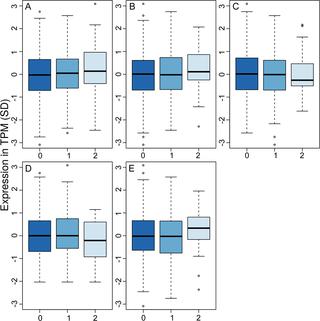当前位置:
X-MOL 学术
›
PLOS Genet.
›
论文详情
Our official English website, www.x-mol.net, welcomes your feedback! (Note: you will need to create a separate account there.)
The derived allele of a novel intergenic variant at chromosome 11 associates with lower body mass index and a favorable metabolic phenotype in Greenlanders.
PLOS Genetics ( IF 4.5 ) Pub Date : 2020-01-24 , DOI: 10.1371/journal.pgen.1008544 Mette K Andersen 1 , Emil Jørsboe 2 , Line Skotte 3 , Kristian Hanghøj 2 , Camilla H Sandholt 1 , Ida Moltke 2 , Niels Grarup 1 , Timo Kern 1 , Yuvaraj Mahendran 1, 4 , Bolette Søborg 3 , Peter Bjerregaard 5 , Christina V L Larsen 5, 6 , Inger K Dahl-Petersen 5 , Hemant K Tiwari 7 , Bjarke Feenstra 3 , Anders Koch 3, 6, 8 , Howard W Wiener 9 , Scarlett E Hopkins 10, 11 , Oluf Pedersen 1 , Mads Melbye 3, 12, 13 , Bert B Boyer 10, 11 , Marit E Jørgensen 5, 6, 14 , Anders Albrechtsen 2 , Torben Hansen 1, 15
PLOS Genetics ( IF 4.5 ) Pub Date : 2020-01-24 , DOI: 10.1371/journal.pgen.1008544 Mette K Andersen 1 , Emil Jørsboe 2 , Line Skotte 3 , Kristian Hanghøj 2 , Camilla H Sandholt 1 , Ida Moltke 2 , Niels Grarup 1 , Timo Kern 1 , Yuvaraj Mahendran 1, 4 , Bolette Søborg 3 , Peter Bjerregaard 5 , Christina V L Larsen 5, 6 , Inger K Dahl-Petersen 5 , Hemant K Tiwari 7 , Bjarke Feenstra 3 , Anders Koch 3, 6, 8 , Howard W Wiener 9 , Scarlett E Hopkins 10, 11 , Oluf Pedersen 1 , Mads Melbye 3, 12, 13 , Bert B Boyer 10, 11 , Marit E Jørgensen 5, 6, 14 , Anders Albrechtsen 2 , Torben Hansen 1, 15
Affiliation

|
The genetic architecture of the small and isolated Greenlandic population is advantageous for identification of novel genetic variants associated with cardio-metabolic traits. We aimed to identify genetic loci associated with body mass index (BMI), to expand the knowledge of the genetic and biological mechanisms underlying obesity. Stage 1 BMI-association analyses were performed in 4,626 Greenlanders. Stage 2 replication and meta-analysis were performed in additional cohorts comprising 1,058 Yup'ik Alaska Native people, and 1,529 Greenlanders. Obesity-related traits were assessed in the stage 1 study population. We identified a common variant on chromosome 11, rs4936356, where the derived G-allele had a frequency of 24% in the stage 1 study population. The derived allele was genome-wide significantly associated with lower BMI (beta (SE), -0.14 SD (0.03), p = 3.2x10-8), corresponding to 0.64 kg/m2 lower BMI per G allele in the stage 1 study population. We observed a similar effect in the Yup'ik cohort (-0.09 SD, p = 0.038), and a non-significant effect in the same direction in the independent Greenlandic stage 2 cohort (-0.03 SD, p = 0.514). The association remained genome-wide significant in meta-analysis of the Arctic cohorts (-0.10 SD (0.02), p = 4.7x10-8). Moreover, the variant was associated with a leaner body type (weight, -1.68 (0.37) kg; waist circumference, -1.52 (0.33) cm; hip circumference, -0.85 (0.24) cm; lean mass, -0.84 (0.19) kg; fat mass and percent, -1.66 (0.33) kg and -1.39 (0.27) %; visceral adipose tissue, -0.30 (0.07) cm; subcutaneous adipose tissue, -0.16 (0.05) cm, all p<0.0002), lower insulin resistance (HOMA-IR, -0.12 (0.04), p = 0.00021), and favorable lipid levels (triglyceride, -0.05 (0.02) mmol/l, p = 0.025; HDL-cholesterol, 0.04 (0.01) mmol/l, p = 0.0015). In conclusion, we identified a novel variant, where the derived G-allele possibly associated with lower BMI in Arctic populations, and as a consequence also leaner body type, lower insulin resistance, and a favorable lipid profile.
中文翻译:

11 号染色体上的一种新型基因间变异的衍生等位基因与格陵兰人较低的体重指数和有利的代谢表型相关。
小而孤立的格陵兰人口的遗传结构有利于鉴定与心脏代谢特征相关的新遗传变异。我们旨在确定与体重指数 (BMI) 相关的基因位点,以扩大对肥胖背后的遗传和生物学机制的了解。在 4,626 名格陵兰人中进行了第一阶段 BMI 关联分析。第 2 阶段的复制和荟萃分析在其他队列中进行,包括 1,058 名 Yup'ik 阿拉斯加原住民和 1,529 名格陵兰人。在第 1 阶段研究人群中评估了肥胖相关性状。我们在 11 号染色体上发现了一个常见变异体 rs4936356,其中衍生的 G 等位基因在 1 阶段研究人群中的频率为 24%。衍生的等位基因在全基因组范围内与较低的 BMI (beta (SE), -0. 14 SD (0.03), p = 3.2x10-8),对应于 1 阶段研究人群中每个 G 等位基因的 0.64 kg/m2 较低的 BMI。我们在 Yup'ik 队列中观察到类似的效果(-0.09 SD,p = 0.038),在独立的格陵兰第 2 阶段队列中观察到相同方向的非显着效果(-0.03 SD,p = 0.514)。在北极队列的荟萃分析中,该关联在全基因组范围内仍然显着(-0.10 SD (0.02),p = 4.7x10-8)。此外,该变体与更瘦的体型相关(体重,-1.68(0.37)公斤;腰围,-1.52(0.33)厘米;臀围,-0.85(0.24)厘米;瘦体重,-0.84(0.19)公斤) ;脂肪量和百分比,-1.66 (0.33) kg 和 -1.39 (0.27) %;内脏脂肪组织,-0.30 (0.07) cm;皮下脂肪组织,-0.16 (0.05) cm,所有 p<0.0002),降低胰岛素电阻 (HOMA-IR, -0.12 (0.04), p = 0.00021), 和有利的血脂水平(甘油三酯,-0.05 (0.02) mmol/l,p = 0.025;HDL-胆固醇,0.04 (0.01) mmol/l,p = 0.0015)。总之,我们确定了一个新的变体,其中衍生的 G 等位基因可能与北极人群中较低的 BMI 相关,因此也与更瘦的体型、更低的胰岛素抵抗和有利的血脂有关。
更新日期:2020-02-18
中文翻译:

11 号染色体上的一种新型基因间变异的衍生等位基因与格陵兰人较低的体重指数和有利的代谢表型相关。
小而孤立的格陵兰人口的遗传结构有利于鉴定与心脏代谢特征相关的新遗传变异。我们旨在确定与体重指数 (BMI) 相关的基因位点,以扩大对肥胖背后的遗传和生物学机制的了解。在 4,626 名格陵兰人中进行了第一阶段 BMI 关联分析。第 2 阶段的复制和荟萃分析在其他队列中进行,包括 1,058 名 Yup'ik 阿拉斯加原住民和 1,529 名格陵兰人。在第 1 阶段研究人群中评估了肥胖相关性状。我们在 11 号染色体上发现了一个常见变异体 rs4936356,其中衍生的 G 等位基因在 1 阶段研究人群中的频率为 24%。衍生的等位基因在全基因组范围内与较低的 BMI (beta (SE), -0. 14 SD (0.03), p = 3.2x10-8),对应于 1 阶段研究人群中每个 G 等位基因的 0.64 kg/m2 较低的 BMI。我们在 Yup'ik 队列中观察到类似的效果(-0.09 SD,p = 0.038),在独立的格陵兰第 2 阶段队列中观察到相同方向的非显着效果(-0.03 SD,p = 0.514)。在北极队列的荟萃分析中,该关联在全基因组范围内仍然显着(-0.10 SD (0.02),p = 4.7x10-8)。此外,该变体与更瘦的体型相关(体重,-1.68(0.37)公斤;腰围,-1.52(0.33)厘米;臀围,-0.85(0.24)厘米;瘦体重,-0.84(0.19)公斤) ;脂肪量和百分比,-1.66 (0.33) kg 和 -1.39 (0.27) %;内脏脂肪组织,-0.30 (0.07) cm;皮下脂肪组织,-0.16 (0.05) cm,所有 p<0.0002),降低胰岛素电阻 (HOMA-IR, -0.12 (0.04), p = 0.00021), 和有利的血脂水平(甘油三酯,-0.05 (0.02) mmol/l,p = 0.025;HDL-胆固醇,0.04 (0.01) mmol/l,p = 0.0015)。总之,我们确定了一个新的变体,其中衍生的 G 等位基因可能与北极人群中较低的 BMI 相关,因此也与更瘦的体型、更低的胰岛素抵抗和有利的血脂有关。



























 京公网安备 11010802027423号
京公网安备 11010802027423号